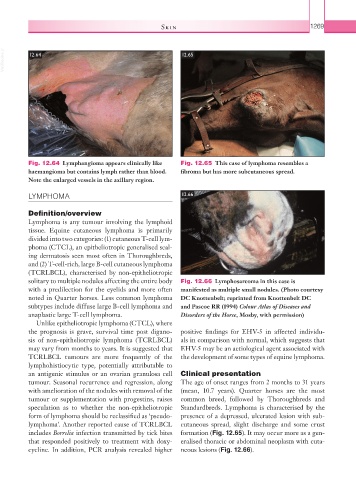Page 1294 - Equine Clinical Medicine, Surgery and Reproduction, 2nd Edition
P. 1294
Skin 1269
VetBooks.ir 12.64 12.65
Fig. 12.64 Lymphangioma appears clinically like Fig. 12.65 This case of lymphoma resembles a
haemangioma but contains lymph rather than blood. fibroma but has more subcutaneous spread.
Note the enlarged vessels in the axillary region.
LYMPHOMA 12.66
Definition/overview
Lymphoma is any tumour involving the lymphoid
tissue. Equine cutaneous lymphoma is primarily
divided into two categories: (1) cutaneous T-cell lym-
phoma (CTCL), an epitheliotropic generalised scal-
ing dermatosis seen most often in Thoroughbreds,
and (2) T-cell-rich, large B-cell cutaneous lymphoma
(TCRLBCL), characterised by non-epitheliotropic
solitary to multiple nodules affecting the entire body Fig. 12.66 Lymphosarcoma in this case is
with a predilection for the eyelids and more often manifested as multiple small nodules. (Photo courtesy
noted in Quarter horses. Less common lymphoma DC Knottenbelt; reprinted from Knottenbelt DC
subtypes include diffuse large B-cell lymphoma and and Pascoe RR (1994) Colour Atlas of Diseases and
anaplastic large T-cell lymphoma. Disorders of the Horse, Mosby, with permission)
Unlike epitheliotropic lymphoma (CTCL), where
the prognosis is grave, survival time post digano- positive findings for EHV-5 in affected individu-
sis of non-epitheliotropic lymphoma (TCRLBCL) als in comparison with normal, which suggests that
may vary from months to years. It is suggested that EHV-5 may be an aetiological agent associated with
TCRLBCL tumours are more frequently of the the development of some types of equine lymphoma.
lymphohistiocytic type, potentially attributable to
an antigenic stimulus or an ovarian granulosa cell Clinical presentation
tumour. Seasonal recurrence and regression, along The age of onset ranges from 2 months to 31 years
with amelioration of the nodules with removal of the (mean, 10.7 years). Quarter horses are the most
tumour or supplementation with progestins, raises common breed, followed by Thoroughbreds and
speculation as to whether the non-epitheliotropic Standardbreds. Lymphoma is characterised by the
form of lymphoma should be reclassified as ‘pseudo- presence of a depressed, ulcerated lesion with sub-
lymphoma’. Another reported cause of TCRLBCL cutaneous spread, slight discharge and some crust
includes Borrelia infection transmitted by tick bites formation (Fig. 12.65). It may occur more as a gen-
that responded positively to treatment with doxy- eralised thoracic or abdominal neoplasm with cuta-
cycline. In addition, PCR analysis revealed higher neous lesions (Fig. 12.66).

